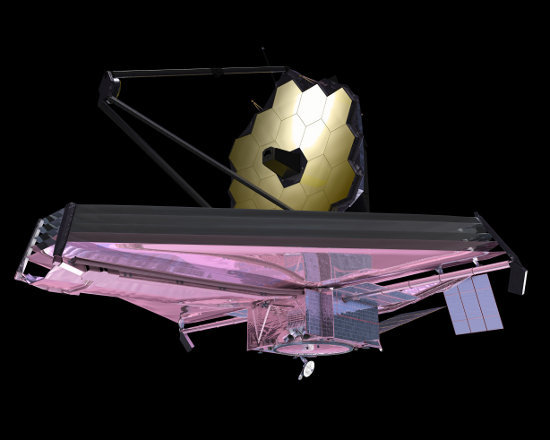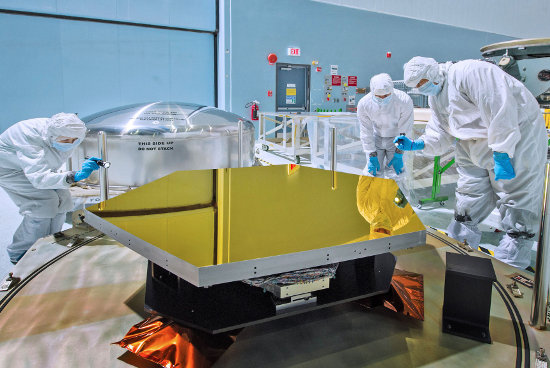The Hubble Space Telescope has arguably been one of the most successful scientific experiments in history. It has produced (among many other things) images of galaxies when the universe was only about half a billion years old (it is now 13.8 billion years old), and has given us a glimpse into the actual composition of the atmospheres of extrasolar planets. Hubble's scientific successor, the James Webb Space Telescope (JWST), will literally infuse new meaning into the phrase "the search for our origins." It will show us the very first galaxies to have formed in our universe, and will identify those extrasolar planets likely to have liquid water (and therefore origin-of-life ingredients) on their surface.
Figure 1. Artist conception of the James Webb Space Telescope. Credit: NASA.
Figure 2. Technicians and scientists check out one of the Webb telescope's first two flight mirrors in the clean room at NASA's Goddard Space Flight Center in Greenbelt, Md. Credit: NASA/Chris Gunn.
The James Webb Space Telescope (Figure 1) represents an ambitious international collaboration led by NASA, with the important participation of the European and Canadian space agencies. The machine itself is nothing short of a marvel, with a gold-coated beryllium mirror 6.5 meters in diameter (Figure 2). The mirror itself is composed of 18 hexagonal segments, which will unfold, origami-like, after the telescope is launched. Since the light from objects in the distant, early universe is significantly redshifted, JWST will observe in infrared light. In addition, the ability of infrared radiation to penetrate through dust and gas (which are opaque to visible light), will allow JWST to peek into regions where new stars and planets are born. The telescope will be equipped with a tennis-court-sized sunshield that will unfurl and protect it from radiation coming from the Sun, Earth, and Moon (Figure 3).
Figure 3. One-third scale Sunshield showing one of the five layers being installed at Northrop Grumman. Credit: Nexolve.
Unlike Hubble, which is in a low-Earth orbit at a distance of just over 300 miles above the surface of the Earth, JWST will be about a million miles from Earth--about four times the distance between the Earth and the Moon.
As amazing as the telescope itself is from a technological perspective, to me personally and to many other astronomers, JWST's chief appeal is in its immense scientific promise. And even in that, two goals stand head and shoulders (or should I say light-years?) above the rest. One is understanding the formation of planetary systems and of the conditions that led to the origin of life. By observing both objects in the outer parts of our own solar system, and the atmospheres of extrasolar planets, JWST will take us one step closer in our quest to find extraterrestrial life.
The second, extremely fascinating topic is that of the so-called "first light"--the very first objects in the universe to have illuminated their surroundings and reionized the cosmic intergalactic gas. JWST could detect the earliest progenitors of today's galaxies, and even the massive explosions (known as pair-instability supernovae) that the first generation of stars is predicted to have produced.
Perhaps even more importantly, however, we have to expect the unexpected. More than half of the major discoveries by the Hubble Space Telescope were not anticipated. I expect nothing less from the James Webb Space Telescope! I cannot wait for its launch in 2018.


